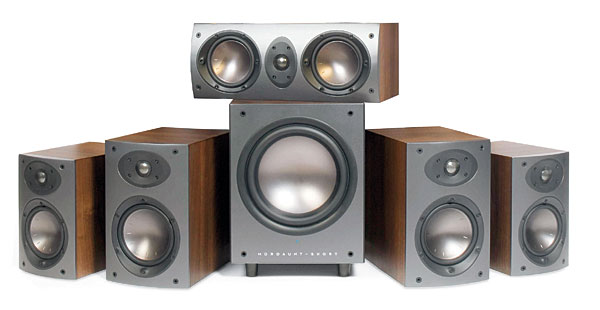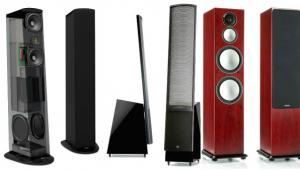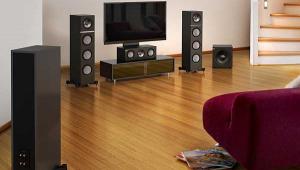HT Guide to Speakers Page 2
Most manufacturers make speaker enclosures beyond a certain size out of MDF. Whether it's covered with vinyl or veneer is more a question of appearance than sound. Don't be ashamed about wanting attractive fit and finish. Along with size, it might be a deal-making or -breaking distinction. Smaller speakers are often made from plastic, which has its own inherent characteristics to try to manage.
To prevent sound waves from enlivening resonances in the enclosures, good designers use a variety of design techniques, including internal bracing, thicker materials, or multiple layers of MDF and other materials. Designers may also ditch the rectangular solid for a curved surface, which helps prevent internal standing waves from developing.
Most speakers use two or more drivers with an internal crossover. A two-way speaker includes a tweeter and a woofer, while a three-way adds a midrange driver and an extra crossover. Driver diaphragms may be made from a variety of materials, each with its own merits. Drivers may use domes (most tweeters), cones (woofers), or flat diaphragms.

Tweeters are often recessed into waveguides that affect dispersion. A shallow waveguide allows wide dispersion; a deep one reduces side-wall and ceiling interaction. Horned speakers often reduce dispersion even further and are usually very efficient—they'll potentially enable your system to play louder.
All other things being equal, larger woofers produce lower bass. However, size is not the sole determinant of bass extension. Cabinet volume plays a role. So does the surround, which holds the outer edges of the driver, as well as the magnet, which propels it, not to mention the designer's intention. Ports may enhance bass response at a certain frequency: make sure they're never blocked by placement (although you may plug them to reduce bass at that frequency).
If you want a sub-less system, scan our measurement charts for rolloff curves. Room acoustics and placement can strongly influence bass response. If possible, assess these things before you buy. Read speaker manuals, often available online, to find how far from the wall you should place the product.
Specs
We measure and chart frequency response. Peaks and notches indicate the natural response of the drivers, effects of cabinet diffraction, crossover-related anomalies, and other quirks. A tolerance of +/–1 decibel is remarkably tight, while a tolerance of +/–6 dB is less so.

We also measure sensitivity, which indicates how many decibels of sound pressure a speaker musters in free air with a 2.38-volt signal from 500 hertz to 2 kilohertz, measured from a distance of 1 meter. While 2.38 volts may sound like an odd number, it's equivalent to 1 watt into an idealized 8-ohm speaker. In an average room with speakers rated at 86 dB or higher, most A/V receivers can produce a satisfying volume level. When you specify in-room efficiency, room reflections and boundary gain boost the speaker's output, which increases the rating by 2 or 3 dB for the same speaker. If you have a big room, you don't necessarily need bigger speakers. Instead, you need speakers that are optimized for a balance of sensitivity and output capability, and often more potent amplifiers, as well.
Impedance affects how a speaker interacts with the amplifier it is connected to. A lower number means the amp will have a tougher load to drive. Although manufacturers typically give a single number for nominal impedance, it varies according to frequency. The listed nominal impedance is, for the most part, a rough guide. An impedance of 6 to 8 ohms should be compatible with almost any A/V receiver. An impedance rating of 4 ohms or lower calls for an appropriately rated AVR or power amp, especially if you run the speakers full range.
Accessories and Connectivity
If you don't mind placing your compact speakers a few feet out from the wall, you should invest in stands. Even a cheap particleboard stand serves the crucial function of keeping the tweeters at ear level. You can fill some stands with sand to make them more acoustically inert. Spikes or cones help couple the stand to the floor. This option helps level the speaker and gives it a stable, less resonant foundation, but it does little to stop transmitting bass frequencies to your downstairs neighbors.
Manufacturers usually use binding posts as the speaker terminals. Carefully inspect the construction quality of speakers with spring-loaded wire clips since these signal-stranglers break easily. Although binding posts vary in construction, most accept bare wire tips, hook-like spade lugs, banana plugs, or pin connectors. Bare wire is the most direct connection. The only drawback is that exposed copper corrodes over time. You can always restrip it, but gold connectors resist corrosion.

A speaker may have an extra pair of binding posts, which enable biwiring or biamplification. Biwiring gives the low and mid/high sections each a direct path to the same amp channel, resulting in improved damping and other subtle improvements. You can achieve more robust dynamics with biamping, in which a separate amp channel serves each driver. This puts you in rack-full-of-amps territory. However, some receivers do reroute the back-surround (sixth and seventh) channels, if unused, to biamplify the front left and right speakers. Speakers that have dual terminals usually come with detachable bridges, so you're not obligated to use this feature.
The amount of vital current-carrying material (e.g., copper or silver) and construction quality can vary widely among speaker cables. Make sure anything you buy is at least 16-gauge or lower (lower means thicker) for short runs. I recommend using 12-gauge or lower for long runs.
Listening
You need only two crucial qualifications for listening. One is your physical ability to hear. And the other is your perception of what you hear. Never leave home without them. Having established that, be confident in your listening ability. Human hearing varies. Not only do individuals hear differently, but training and experience influence how we perceive what we hear. Really, you are the sole authority on what satisfies you.
The most common listening mistake is to ignore the midrange in favor of splashy highs and powerful lows. Then you'll end up with a sizzle-and-boom system. The most important stuff lies in the middle, where your hearing acuity is concentrated. Is the midrange peaky or recessed? Do voices sound natural, or do they sound nasal, congested, shrill, tubby, or veiled? Does dialogue sound consistently intelligible?
Listen for spatial character. The best speakers—even in just a stereo pair—can produce a convincing left-to-right soundstage, with front-to-back depth as well. Surround sound adds depth, which turns the soundstage into a soundfield. The soundfield should feel wide and deep and extend beyond the outer limits of the speakers. If panning sounds uneven, left to right or front to back, the speakers are not well matched.
The wider the dynamics, the better. When a good amp drives good speakers, the sound doesn't compress or break up at powerful peak moments. Great speakers work equally well at low-level resolution. They make a whisper audible and generate a palpable soundfield, even at low volumes. A great pianist once observed that the best pianos create a convincing pianissimo. The same is true of speakers.
Part of listening involves feeling, a process that involves both conscious and subconscious thought. Trust your instincts. They may be a step or two ahead of what you're consciously pondering. Watch out for fatigue and boredom. Either one can be a serious warning sign.
More so than many other products, you must extensively audition speakers before you commit. You should either bring a lot of familiar material to the listening room or be certain that you're getting a money-back guarantee. Believe in your hearing, and the rest will follow.
















































